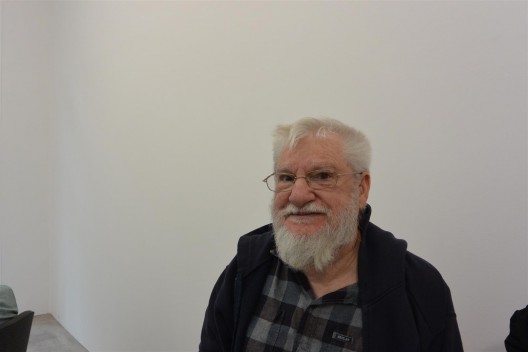When I first saw Dan Graham, he stood almost anonymously by the wall, white hair and beard, a checked-flannel shirt and old cardigan. Sometimes people approached him but he seemed content left to his own thoughts. In the middle of the room was “Passage Intime” one of his roofless glass pavilions, two concave walls creating a time-tunnel bisecting the room. People seemed wary of entering. Most stood in the courtyard outside, sometimes glancing through the windows to the exhibition. His friend introduced us. Dan’s thoughts and opinions tumbled forth—Japanese architecture, Frank Lloyd Wright, music, China, minimalism, poetry, critical of this curator, that artist. He scratched his head.
The show was a preview for the installation of the pavilion in the Place Vendôme during October, with another pavilion, “Two Nodes”. Upstairs were a selection of Dan’s architectural house photography and sketches. Downstairs was a new collaborative film on the history of rock music, “Don’t Trust People Over 30”, involving strange marionettes and a curved screen. I walked home in the rain, regretting I had not had longer to speak with the artist, to record the conversation.
A week later I was in Brussels. I walked into 67, Rue de la Régence, an old publishing house and printery now home to a clutch of galleries, near the Palais de Justice and Sablon district’s antique shops. By luck, another Dan Graham show was to open, at Galerie Micheline Szwajcer. Here was a round pavilion, with a single portal,,crowding the delicately plastered Belle Étage reception room.
I met Micheline and mentioned meeting Dan. She invited me to join them for an early dinner.
The main thing about Chinese art
Dan Graham: You know, Marianne Brouwer did a very important show at Witte de With in the 80’s. Huang Yong-Ping is now making works that are too large but his early pieces were great. Strangely enough, he now lives near Dijon, in a very remote area.
I think the main thing about Chinese art is the humor. I think the photography is very good also.
Chris Moore: It is, but the photography tends to be performance-based.
DG: Well, I saw in the Guangzhou Triennial some very good small photographic things. I was there some years ago.
CM: I was looking at the pavilion.
DG: Yes, the Marian Goodman piece is actually going to Place Vendome, for one month.
CM: I think it should be permanent.
DG: Well, my work doesn’t really sell anymore. There’s no interest in it—only my dealers, Marian, Micheline and in Copenhagen. My work is basically unsalable. All the shows I’ve done in the last few years have sold nothing.
The comment hides his supporters, including people like Daniel Birnbaum. There would be a number of choleric moments during our discussion but Dan would quickly switch to being critical or humorous.
I’m serious! It’s a new generation of artists—Daniel Birnbaum supports Eliasson, Liam Gillick, Thomas Demand. There’s really no interest in my work in architecture [well, an installation in Place Vendome is hardly bad]. It’s been a real change because you’ve got people who oversimplified things I was doing and they’re basically making spectacle.
CM: When I saw the Louis Vuitton foundation in Paris I really disliked the Olafur Eliasson installation. [a series of mirrored columns refracts the space of the lower water courtyard]
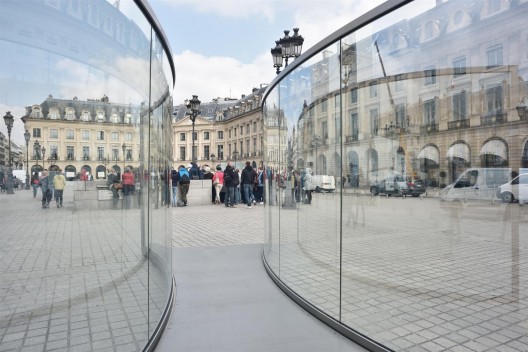
Dan Graham, “Passage Intime”, semi-reflective glass, stainless steel , 230 x 514 x 270 cm, 2015. Courtesy the artist and Marian Goodman Gallery © Marc Domage
DG: I don’t know if you know, in New York around Christmas, there is [a show called] Ice Capades—it’s like an ice show for Christmas, right? A spectacle. On the other hand, he [Eliasson] began in new ways to combine it with Smithson and my work again. Anyway, the Paris piece is called “Passage Intimate.” I liked it because the space at Marian Goodman Gallery is kind of simple and rectilinear. I wanted to make it into something very close.
CM: I was looking at how people react to it…it’s like a wormhole.
DG: I think it worked during the opening because there’s a flow of people.
CM: But a lot of people did not like going through it.
DG: No… yes, well, [like it says] in my press release for “Passage Intimate”, it’s almost like a relationship. In other words, you can be too close—right?—to people that you’re living with, or it can be very intimate; intimacy also means a blockage for men. Or a trap; so consciously I’m maybe playing on that. There’s also my work on the outside—a funhouse for children.
CM: Yes, I like this idea.
DG: It’s a funhouse for children and a photo opportunity for parents.
Dan’s voice is melodious and bubbling, masking with the same color reflectiveness, critique and a sardonic humor. A mischievous smile escapes momentarily.
CM: Well, we have to make a distinction between something that is “childlike”, the state of innocence and exploration, and “childish”, someone immature. This is childlike.
Nausea
DG: When I was 14, I read Jean Paul’s Sartre “Being and Nothingness.”
CM: You liked it?
DG: No. No, no.
CM: It bored me silly—I read it at the same age.
DG: No, first I read “Nausea” because I hated school, but then I went on to “Being and Nothingness,” and I think Lacan took a lot from this idea of the gaze, right?
We are discussing the relationship between movement and subjectivity; to be a person is to move in space; so through experience we conceive ourselves—visually and physically—as bodies in motion.
So my work is a little bit against minimal art [which often presupposes a stationery subject/visitor]; it’s into subjective space between two [points]… and also people in the flow [movement]. So as the sky changes—as it was during the opening—you have a play between transparency and reflectiveness, which is always shifting. Also, the space, the curve [of the walls] is 360 degrees of the space of the body and also [looking up] the sky-scape. [Which is to say, the pavilions are not about the space of a viewer but the experience of a viewer in a defined space. The curve invites us to turn, our gaze tracking the transparent/reflective wall, which in turn refracts/distorts the landscape behind it]
CM: But the [experience of the pavilion] changes depending on whether it’s situated inside or outside—when it’s in Place Vendome, it’s going to shift with the weather.
DG: Its better outside, I think. When I was siting the piece at Place Vendome, [I noticed that] along the very edges of the Place, people on motorcycles go in a kind of a circle. So I want the pavilion to be seen from the [circling] motorcycles but also from the aluminum columns that block the passage of the cars and that people sit on, talking on their mobile phones. The big column [in the middle of the Place] is almost irrelevant; it’s too big.
CM: Your work is very much about movement—time and space.
DG: It’s about time changing. If you walk around [the pavilion], it changes. Which is very different from minimal work, which is static.
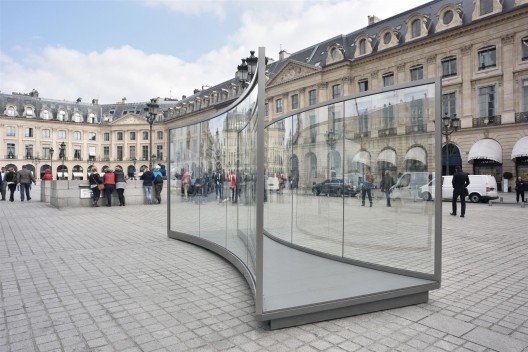
Dan Graham, “Passage Intime”, semi-reflective glass, stainless steel , 230 x 514 x 270 cm, 2015. Courtesy the artist and Marian Goodman Gallery © Marc Domage
Renaissance, Baroque, Rococo perspectives
DG: Well the other thing is, from my Dia piece through to the piece at the Met, my work is about the city plan. But also there is a play between Baroque and Renaissance perspective. So Micheline’s space is a kind of [a] elegant rectangle—it’s actually very, very hard to do a work there—and my architect, Kris Kimpe, wanted to make the pavilion rectilinear. The person who interviewed me for Le Soir, she is an expert on Rococo and she said this was Rococo. You know, [the best] Rococo architects were actually Belgian.
CM: Really?
DG: François de Cuvilliés, who did the Amalienburg pavilion in Munich, was from Belgium [a hunting lodge built 1734-1739, at Schloss Nymphenburg, Munich]. I don’t know whether it’s Baroque or Baroque-Rococo but I’m interested in that use of glass. I was very influenced by seeing the Amalienburg. The Amalienburg and other parts of the Nymphenburg were done by Cuvilliés, who was a dwarf from Wallonia. Wallonia produced actually all the great Rococo [architecture].
Asymmetry
DG: My work is asymmetrical, which is very hard to do with Kris Kimpe, because he doesn’t like the asymmetry.
CM: It’s a-symmetrical?
DG: Yes, in other words the entrances are not parallel to each other.
CM: Yes, I noticed that.
DG: I had a gallery briefly that failed, and I showed both (1928-2007) LeWitt and Dan Flavin (1933-1966), and they both were garishly big shows about Russian Constructivism. So I was very influenced by Flavin’s use of the Russian constructivist diagonal. I always use this kind of off-diagonal. I don’t want to do symmetrical work—my work is always a slightly off-regular diagonal. It comes from Tatlin—all minimal art. You know that Frank Stella’s early work comes from Rodchenko?
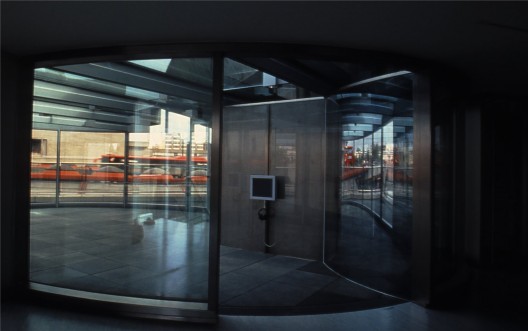
Dan Graham, “Waterloo Sunset” at the Hayward Gallery, London, stainless steel, two-way mirror glass, 2002-2003.
Itsuko Hasegawa
My favorite architect is Itsuko Hasegawa. A great architect from Japan.
Curators
DG: I don’t like those curators who are power players.
CM: Well there are a few people like this. They forget the reason behind curating.
DG: They follow trends and they bring in trendy things.
The garden and the museum
DG: When I started working in Europe, the work that I was doing in the ’80s was actually with the regional art associations in France. They were all situated in gardens with different historical overlays. I wrote an article called “Garden as Theater as Museum”, an attack on Buren, because Daniel thinks the museum is fixed historically, whereas I think it always changes. I think in [Western] Europe in the ’80s, beginning with documenta and Munster [Sculpture Project], all the [innovative] museums were actually parks with overlays of different historical periods. And people came to these museums with their children and cars. They would camp out on Saturday, and then on Sunday they would look at the art. I think Jan Hoet (1936-2004) [director of documenta IX in Kassel, 1992] wanted to make documenta into something like entertainment, and I think park museums are entertainment and education for the whole family.
My first idea for pavilions though, came from the fact that I was interested in street furniture, like bus stations and telephone booths, and I wanted to combine that with the Barcelona pavilion of Mies [van der Rohe]. An interesting thing about Mies’s Barcelona pavilion is it was landscape; it had hedges around it. And I think Mies learned an awful lot from Schinkel. [Karl Friedrich Schinkel (1781-1841), prolific Prussian ‘Empire’ architect and designer of the Altes Museum in Berlin (1823-1829), the template for van der Rohe’s glass and steel Neue Nationalgalerie in Berlin, 1962-1968)]
…
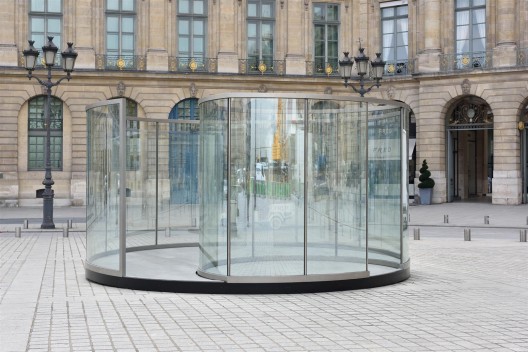
Dan Graham , “Two Nodes”, semi-reflective glass, stainless steel, 490 cm x 230 cm, 2015. Courtesy the artist and Marian Goodman Gallery. © Marc Domage
Belgium and Broodthaers
DG: I first came to Europe around ’70-’71to be in a show in Cologne about people doing projects: a show called Projected Art, it was about artists working in film and video. In terms of Belgium, what happened was, I had this conceptual piece on the side effects of common drugs from magazine pages, which was in the back room of John Gibson Gallery. John Gibson spent a lot of time going to Belgium—he introduced Marian Goodman, actually, to the work of Broodthaers (1924-1976). Herman Daled who was at a medical convention in New York, saw “Side Effects/Common Drug” (1966), he liked it and he showed it to Marcel Broodthaers. So I [joined] MTL Gallery. Basically I was so much in love with Fernand Spillemaeckers as a person, after he died I didn’t want to show at Micheline’s. It took me a long time to be convinced. I didn’t want to show in Belgium because I was in love with Fernand so much. I was very emotional about Fernand, he was a very special person. He was so full of contradictions; he wanted to be a philosopher. What I liked about this gallery, MTL, is that they showed Marcel Broodthaers—who is actually a poet—and they showed Stanley Brouwn (b.1935). When I was in a conference about Marcel Broodthaers, I mentioned that I think a lot of Marcel’s work comes out of the relationship with Stanley, because it’s about the map of the city of Brussels, it’s about topology, right? It had a lot to do with where the museums were in the center of Brussels. The other thing I think was happening in Brussels, in that time period, was [that] everybody was fascinated by English performers. They liked Gilbert and George. And I think maybe there was an interest in Bruce McLean (b.1944) whose performance group was called “Nice Style”. And I remember staying with Yves Gevaert at the very edges of Brussels and all the buildings [there] looked British, right? They had English Tudor style. So there was a fascination. Also Marcel Broodthaers used to dress up as an English gentleman and take the ferry to Britain.
CM: Maybe it’s got something to do with people called Marcel. Marcel Proust was also a total Anglophile…
DG: Now the important thing about me and Marcel, was that we all wanted to be writers. Marcel was a poet.
CM: I didn’t know that.
DG: Oh yes he was basically a poet, not an artist. When I started my gallery—friends started it—I didn’t know anything about art but the first show I did was a Christmas show with artists who came to the gallery. [Through that] I became friends with Sol LeWitt because Sol and I liked this writer Michel Butor and disliked Robbe Grillet. Whereas we all wanted to be artist-writers, Smithson wanted to be like Borges, so also even Andy Warhol, even though he was dyslexic—he couldn’t read—but he was a great writer, right?
CM: But there’s quite a few people like that.
DG: Yes, but he actually dictated his books.
CM: That’s explains a lot!
DG: So, we saw ourselves as artist-writers. And my first conceptual pieces were magazine pages, because the idea in the art world in the late ’60s was to destroy value. Carl Andre wanted his bricks to go back to the store where he bought them. [Dan] Flavin wanted his lights, neon lights, to go back to the store. Lichtenstein said he wanted to destroy painting by putting cheap printing matter into painting. They all wanted to destroy value but then their work became valuable—this [destroying value] is a kind of a fantasy! So I put my things in magazine pages. They were disposable. And this is where Godard came into the picture, because [of] his early magazine essays and films like “Two or Three Things I Know About Her” (1967).
…
I became fascinated in Europe by the fact that historical gardens were important, and as I said in [the article] “The museum a garden, the garden as museum”, the first museums were the renaissance gardens. They had political allegories, philosophical allegories, and they had water tricks, like Disneyland. Now, Paris was against the Centre Pompidou and Paris Euro Disney [a theme park for tourists] but Parc de la Villette was about the edge of the city [designed by Bernard Tschumi from 1984-87 on the site of the former Napoleonic slaughterhouses]. It was the creation of a wonderful woman urbanist, Françoise Chouay (b.1925) [Chouay was one of the design Jury members]. I think the secret to my work is urbanism. I learned a lot from Sol LeWitt, who I showed in my gallery. Sol worked for IM Pei [the architect], and Sol also said his favorite artist was de Chirico, because he said de Chirico depicted the city plan of Torino. So my first work, “Homes for America”, was about the city plan of suburbia. De Chirico also influenced enormously Aldo Rossi. Sol said it and Carl Andre said his biggest influence was Agnes Martin and Brancusi’s bases. The other person who was very helpful to me is Marianne Brouwer (b.1942). She has an historical sense.
I also got involved in landscape architecture for another reason. I’m from suburbia and what I love about Belgium is it’s like a suburban Versailles—there are hedges everywhere.
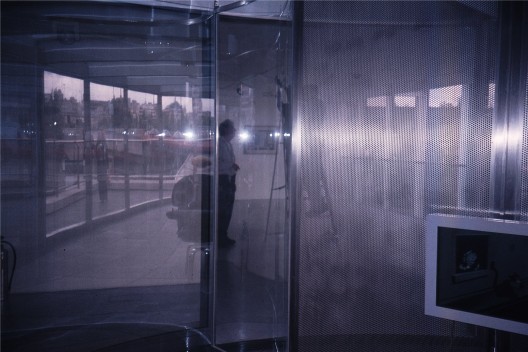
Dan Graham, “Waterloo Sunset” at the Hayward Gallery, London, stainless steel, two-way mirror glass, 2002-2003.
CM: [Laughing] Okay.
DG: Or you haven’t really been around Belgium–everything is hedges.
CM: That’s very English.
DG: I think hedges define the edge of a city. Private houses have hedges. My favorite writer about art, TJ Clark, Tim Clark, said the most radical work of Van Gogh were actually the things he did at the very edge of Paris. And my “Homes for America” is really about this as a new city plan. Because I thought the idea of the white cube as a basis for art and art echoing the white cube of the gallery didn’t make any sense.
CM: It’s true. It doesn’t make sense because you don’t live like this.
DG: I grew up in suburbs, by the way [fittingly, Urbana, Illinois]. Of course, as an Australian, you know the importance of car culture, of automobile culture. I did see Mad Max—I saw it again on the airplane.
CM: I missed it! I wanted to see it in the cinema.
DG: The new one?
CM: Yes.
DG: I haven’t seen the new one either. My favorite Australian film, by the way, is actually Holy Smoke, a Jane Campion film with Kate Winslet.
CM: Really? You like that?
DG: I thought it was hilariously funny.
CM: When you take it that way, yes.
DG: But also all of Jane Campion’s films are about upper-lower class Australians. It’s about the upper-lower class of Australia.
CM: It’s true.
DG: She makes fun of them but according to TJ Clark, that’s the revolutionary class. The Petit Bourgeois is the revolutionary class. The people who collect my work are professional, middle class people. Doctors, I think, like art because they are very clinical, right? So Freud liked to have African art. And I think doctors like the idea that art is actually physical, because they can be physical, and they also like to do research. In other words, they research conceptual art-type art. So my first collector was a radiologist, Herman Daled [the Belgian collector]. We say about doctors that some of them have a good bedside manner. In other words, Herman knows how to flirt with his patients.
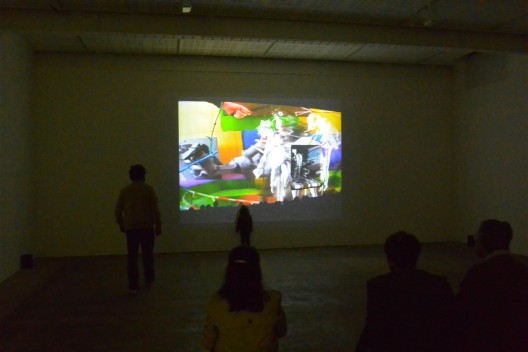
Dan Graham in collaboration with Rodney Graham, Tony Oursler, Phillip Huber, Laurent Bergen and Japanther, “Don’t Trust Anyone Over Thirty”, video, 2004. Photo: Chris Moore.
Dean Martin
I love Dean Martin, he’s my hero. I wrote an article about the Dean Martin’s TV show as entertainment. I think he’s a great actor. Godard talks about him in “Some Came Running” and he was great in the Howard Hawks film, “Rio Bravo”, with Kim Nowak.
Chinese gardens
DG: I love Chinese gardens. I did a piece called “Triangular Pavilion with Circular Cutout” (1989-2001), because Chinese garden openings [windows] in a way give you a view of the next room, right? And also it’s like the moon, the shadow of the moon and, of course, the male part and the female part are, of course, the physical and material and the female part is the shadows. So I actually went to China for only one reason. I was in the [2nd] Guangzhou Triennale [2005] and I went to see a Chinese garden.
CM: You went to Suzhou?
DG: No, I couldn’t go there, I actually went to Guangzhou, to the edge of Guangzhou, and in an industrial slum there was an old garden. So we’re talking about the garden pavilion, in a way.
Surveillance and Jimmy Carter
CM: With your pavilions, your movement is absolutely crucial, and where you are, and the relationship of you to other people.
DG: And the movement in the sky, as well.
CM: Yes. Which is why it doesn’t have the roof.
DG: Also because my work is anti-corporation. My work uses the corporate two-way mirror glass, which is one-way in Europe. The outside reflects the sky. This is the Jimmy Carter idea that we would cut down emission costs [presumable from air-conditioning], but it’s actually surveillance because you can see from the inside without being seen on the outside. And the outside actually shows [reflects] the view; a view of the sky and the sun. So the corporation identifies itself with the sky and with ecology, right? So I’m trying to make my work into a pleasure situation. Everybody thinks my work is about alienation but it’s about a semi-leftist artist like me making fun of corporations, playing kind of a part-dalliance.
Another big influence is actually Georges Seurat (1859-91). My friend Peter Finchley said you can tell with Seurat, outside the circus area, that people [in his pictures] are workers, because their clothes and boots are very stiff. I think he was revolutionary.
CM: I love his drawings. They understand the whole concept of a drawing is a bringing out of something, an emergence, and his drawings emerge from nothing—they emerge from the paper.
DG: I also like the fact he painted on the frame. That also blurs the distinction between the illusion and the physicality of the frame.
For me it’s just intuitive. I never intellectualized it but I [later] realized the piece I did for the Met, the Metropolitan Museum of Art, with Günther Vogt, the landscape architect, was like a Seurat painting. I used Astroturf because the roof is very tacky to begin with. So my piece is a little like [with] Bruce Nauman—I mean the kind of recurrent mirrors on the inside of the pavilion, the curvatures; that’s the baroque. Whereas the fence of the Met [roof] has some not very interesting hedges but you can see against the hedges the treetops of Central Park. And in my piece people liked to go there and see the Manhattan towers reflected in the pavilion and they were lying on the Astroturf like in a Seurat painting.
Photography
CM: How do you see the relationship of photography to your work as opposed to, say, drawing?
DG: That’s a very good question because I never went to art school. I took photographs as a hobby, like Ed Ruscha; but I think in a way they are almost like drawings for projects later. It’s very unconscious.
My two favorite photographers are Wolfgang Tillmans (b.1968)—I love his work and he is a very lovely person, very modest—and I like Ed Ruscha (b.1937). The interesting thing about Ed Ruscha is that his hero was the same as Flavin’s, the American painter [Albert] Bierstadt from Prussia (1830-1902). Flavin was a big supporter of my work, because a lot of my work is to do with light. That’s why it does so well in Scandinavia.
CM: So taking photographs, this is like taking notes, this is your drawing, your sketches?
DG: For me it’s a hobby. I think photography is enjoyable.
CM: How do you make notes—you’ve got sketchbooks? Do you draw or do you take…?
DG: I’m going to admit something that Kris Kimpe teases me about. I buy books about architecture, we look at architecture as a hobby, and then we look at the architecture plans, and we don’t steal exactly, we modify things we see in architecture books. In other words I make a photocopy of something I like and then I keep making changes on the photocopy.
CM: So that’s the thinking process?
DG: No, it’s called drawing!
CM: It’s the same thing, isn’t it? Drawing is a thinking process; it’s a journey, whereas a painting is usually showing you the end product. But a drawing is never finished, it’s the infinitive.
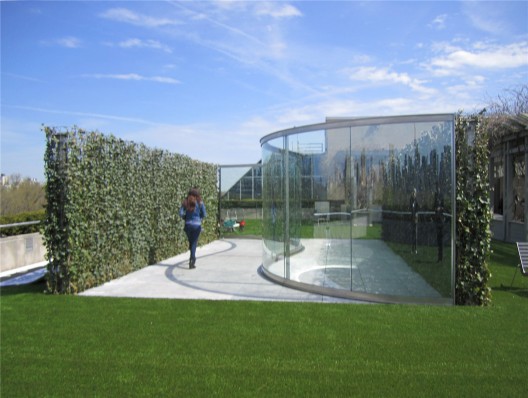
Dan Graham in collaboration with Günther Vogt, “Hedge Two-Way Mirror Walkabout”, stainless steel, hedge, two-way mirror glass, 2014.
…
DG: I have a confession to make. My two favorite countries in the world are both countries not thought highly of in Europe: Belgium and Portugal. Portugal has had the best museum in Europe for a long time; the Serralves Museum. [***LINK: http://www.serralves.pt/en/ ] The director was João Fernandes. Now he’s at Reina Sofia [Deputy Director]. [***LINK: http://www.museoreinasofia.es/en ] I’ll describe the piece of mine that’s my favorite piece that I did—my two favorite pieces. One of them is “Waterloo Sunset” at the Hayward Gallery. The other one is a piece called “Double Exposure”, it’s a triangular pavilion, which can be entered. Two sides are two-way mirrors and the front a Cibachrome film facade. The front was actually a Cibachrome film, back-illuminated, with a photograph of landscapes 50 meters in front. So you can look through it and time changes. It’s a landscape pavilion.
…
DG: Actually I think the Micheline Szwajcer piece works better in its installation. It’s because it fits the gallery and plays games with it, right? Also it’s because I had a long series of angry emails back and forth between me and Kris Kimpe. That’s how you get good pieces. I also did this with Gloria Moure—we would have violent arguments, Gloria and I, while we were doing the shows; we were both Aries bellowing. We would have big arguments and then we would come up with a solution. So when you do shows it’s very important to have arguments and discussions, right? Correct? That’s how you make a good exhibition.
Bibliography notes
“Garden as Theater as Museum”, first published in Chris Dercon, ed., Theatergarden bestiarium: The Garden as Theater as Museum (Cambridge, Mass.: MIT Press, 1990), pp. 86-105. The text was written in conjunction with the exhibition “Theatergarden bestiarium”, curated by Dercon and shown at P.S. 1 Museum, Long Island City, N.Y., Jan 15–Mar 12, 1989, with Glenn Branca, James Coleman, Rodney Graham, Juan Muñoz, Rudiger Schottle and Jeff Wall.
Glouria Moure, Dan Graham: Works and Collected Writings, Ediciones Poligrafa, Barcelona, 2009.
* * *
Dan Graham “Passage Intime” and “Two Nodes”
Place Vendôme, 12 Oct.–12 Nov, 2015


